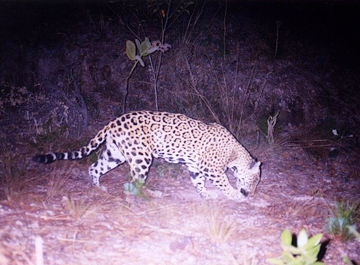|
|
As a result of a research effort by the Autonomous University of the State of Mexico (UAEM) and the University of Alicante (UA), scientists have for the first time photographed a wild jaguar in central Mexico. The sighting has significant conservation implications, showing that the big cat still occurs in central Mexico despite persecution by hunters, habitat destruction, and depletion of prey.
“We obtained three photographs of a male, and ten of the 132 excrement samples found have been attributed to the jaguar,” said Octavio Monroy-Vilchis, a researcher at UAEM and lead author of the study, the results of which are published in The Southwestern Naturalist. “The photographs provide information about new recording sites, and allow us to deduce that the area where the animal was observed may be a corridor connecting jaguar populations.”
 One of the three photographs of the jaguar taken during the research project in the centre of Mexico. Photo: Octavio Monroy-Vilchis et al / SINC |
The photos were taken in the Río Balsas river basin, an area that the Wildlife Conservation Society has declared a “priority area for verifying the presence of jaguars”. Researchers say the basin could act as a corridor for them to move between habitats.
Despite the pictures, the researchers have still yet to see the animal.
“The lack of evidence highlights the fact that the jaguar is more elusive than other felines, and that its presence in the area is sporadic – possibly because it has access to other resources near to Michoacán and Guerrero,” said Monroy-Vilchis.
Monroy-Vilchis, O; Sánchez, O; Aguilera-Reyes, U; Suárez, P; Urios, V. “Jaguar (Panthera onca) in the State of Mexico” Southwestern Naturalist, 53(4): 533-537 diciembre de 2008.